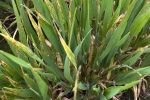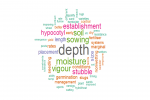The profitability of lentil crops can be limited by two key diseases: Ascochyta blight (Ascochyta) and Botrytis grey mould (Botrytis). In the absence of disease control measures, studies have found that yield losses in lentils from Ascochyta can exceed 70 per cent and from Botrytis can reach 100 per cent.
At the same time, the profitability of lentil crops has intensified production and created a growing reliance on lentil-generated income. That means Ascochyta and Botrytis now pose a distinct risk to farm economics.
This has led to the widespread adoption of prophylactic or preventive fungicide applications to protect lentil grain yields.
A new GRDC investment is enabling a research network led by Agriculture Victoria to explore and refine practices around preventive spraying for lentil and faba bean crops.
The three-year project started in 2023 and is analysing the economics of preventive spraying. The project is assessing different fungicide regimes against lentil varieties with a range of genetic resistance to Ascochyta and Botrytis.
This new understanding will help to ascertain the thresholds at which preventive action is economic and yield-responsive to ensure there is a gross margin benefit from spraying.
There are several components to the project:
- understanding the environmental conditions required to develop Ascochyta and Botrytis disease in the field as well as the contribution of each to yield losses;
- understanding the relationship between varietal disease rating categories and the loss of yield and grain quality;
- understanding the relationship between disease severity and yield or grain quality loss;
- assessing integrated disease management strategies; and
- economic analysis to ensure that management strategies result in lower risk and increased yield and profit margins.
Data is being recorded in ways that support the development of predictive risk assessment tools that further refine the available disease management options. This includes developing climate forecasts that can alert growers to heightened disease risk (see The climate component of disease risk).
In turn, this new understanding can help maximise the longevity of the fungicide products and disease resistance genetics.

Dr Joshua Fanning of Agriculture Victoria. Photo: AgVic
The project involves a series of field trials throughout the northern and southern regions across low to medium-rainfall zones. For lentils, these trials are primarily underway in growers’ paddocks in the following regions:
- the Wimmera and Mallee in Victoria, administered by Agriculture Victoria;
- the mid-north of South Australia, administered by the South Australian Research and Development Institute; and
- the Yorke Peninsula in South Australia, administered by Trengove Consulting.
In the wider project, the New South Wales Department of Primary Industries and Regional Development and Field Applied Research Australia are involved, but with a focus on beans.
The project also has the capability to carry out controlled-environment studies to take a closer look at particular disease aspects, such as optimal temperature for disease emergence.
During 2023 the season produced a dry finish, which provides the three-year project with baseline figures for a low disease severity season. Field days and workshops will be hosted throughout the project for growers and consultants interested in project updates.
More information: Joshua Fanning, joshua.fanning@agriculture.vic.gov.au
Sam Trengove, samtrenny34@hotmail.com

























































